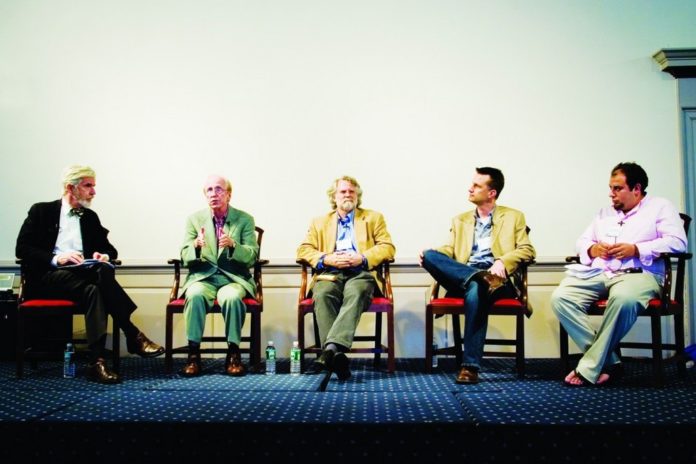
By 2015, technology will have significantly changed life as we live it in the developed world, impacting every aspect of society and the economy.
That message was delivered April 27 at a community forum held at Brown University by the nonprofit technology consortium OSHEAN to discuss the social changes already being caused by rapid advances in technology, as well as to imagine the future.
Technological progress promises to transform medicine, media, education, politics and even governmental and economic models, changing the face of many aspects of society, said the four panelists who spoke at the forum.
“I think we’re living in one of the absolutely great nodes of human experience,” said Christopher Lydon, host of Radio Open Source, who hosted the panel discussion. “It is about the technology, as you know, but it’s about so much more than that. It’s about the architecture of the human community” and beyond.
A new age of medical technology already being developed promises to build better artificial joints, organs and prostheses and find cures for illnesses that have plagued humanity through time immemorial, said Michael J. Lysaght, director of Brown’s Center for Biomedical Engineering.
Medical engineers are increasingly focusing on creating biological therapies for human ailments and injuries through cellular medicine, stem cell research and mining the medical potential of the human genome, Lysaght said.
As an example, Lysaght said that in the near future, artificial knees made from metal and plastic will become obsolete as “living” replacement joints are engineered that integrate into and grow with the patient’s bone and cartilage.
The rate of technical innovation likely will increase in coming years, fueled by a new generation of scientists and engineers trained at cutting-edge universities to tackle complex research from a much younger age, said Phillip Long, associate director of the Massachusetts Institute of Technology’s Office of Educational Innovation and Technology.
At MIT, new project-based learning techniques are allowing freshmen to build nano-reaction chambers as part of a project aimed at using nanotechnology and microfluidics to identify cheaper and easier ways to pinpoint the stages of illness for patients with AIDS, he said.
“This is the kind of thing that students ought to be grappling with from the very beginning, not simply going through and getting a grounding in the math and physics and the chemistry and such, and then later applying it,” Long said.
“They have to address the big problems of the world right from the beginning,” he added. “They may not do it with the kind of thoughtfulness that someone more seasoned has, but they also have the creativity and the lack of boundaries that help them be creative.”
On a social level, the convergence of Internet technology and digital media are already resulting in a radical, democratic shift in the way people consume media, said Jack Templin, a Providence-based IT consultant and the co-founder the social networking group Providence Geeks.
The shift away from TV and newspapers to online platforms that enable users to produce and share news and entertainment content is causing upheaval in traditional media, but Templin said he believes the revolution will ultimately benefit society.
“It’s a strange time and there are such forces at work, but I’m quite optimistic that the more open, modular approach that I think the Internet really embodies is pretty hard to beat,” Templin said.
The media shift is already being taught in some Rhode Island high school classrooms, where teachers are teaching courses on MySpace and personal Web site design, said Seth Goldenberg, director of Rhode Island School of Design’s Office of Public Engagement.
“In this time of challenges in public education, the Internet and technology allows young people to become authors in ways that they’ve just simply never experienced before, and they’re moving from being consumers of media to producers of media, and it’s wonderful,” said Goldenberg. “You know, we often hear about the travesty of funding and the statistics of the graduation rate, but there’s this other anecdotal story about this revolution in every classroom.”












